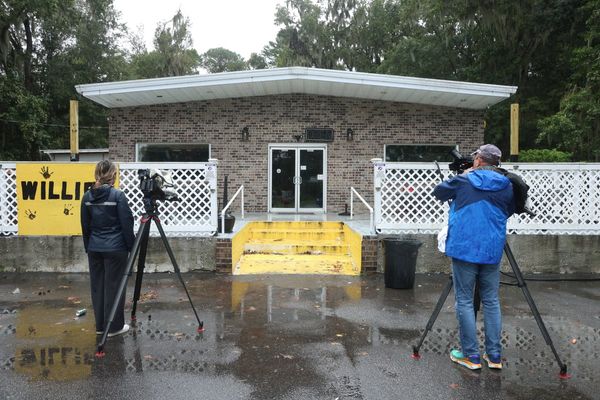President Donald Trump's trade war with China is in full swing and the White House's fast-moving tariff policies have shaken the stock market as well as the global economy. Trump decided on April 9 to pause "reciprocal" tariffs for 90 days. On April 11, he carved out a range of consumer and other China-made electronics on April 11.
Other possible moves, such as taxing foreign made films shown in the U.S. and revising semiconductor trade restrictions, have not actually moved to concrete actions. Amid such uncertainties, here is a rundown of the Trump tariffs currently in place.
Trump Tariffs: U.S.-U.K. Trade Deal Terms Leak Out; S&P 500 Rises
Trump is, on Thursday, purportedly set to announce his first trade deal after shocking the world with his April 2 announcement of bigger-than-expected reciprocal tariffs. S&P 500 futures rallied early on hope that the U.S.-U.K. trade deal could serve as a launching pad for a deal with the European Union and other key trading partners.
The U.S. is reportedly willing to flex on the 25% tariffs imposed on auto and steel imports from the U.K. In return, along with accepting the 10% reciprocal tariff rate, the U.K. plans to pare back or eliminate its 2% tax on digital services revenue from search engines, social media and online marketplaces.
Meanwhile, Trump moved on Wednesday to rescind the Biden administration's last-minute tiered AI-chip restrictions, opposed by many countries and chipmakers such as Nvidia. The Trump administration said it won't go ahead with a Biden-era plan. The plan for a three-tier AI system would limit the most advanced chips to the U.S. and a handful of key allies.
Tariffs Now In Place:
- U.S. vs. World:
- blanket 10% tariffs on all imports
- 25% on steel, aluminum, autos and some auto parts imported to U.S. - U.S. vs. China:
- 145% duties on all China imports to U.S.
(20% fentanyl penalty + raised initial 104% tariff to 125% on April 9,
after China levied retaliatory tariffs. Carve-out exceptions below) - Carved out on April 11:
- Trump issued a rule exempting China-made smartphones, computers and semiconductors from reciprocal U.S. tariffs. The goods remain under the standing 20% tax, a purported fentanyl penalty, on China-made products - China vs. U.S.:
- Raised retaliatory 84% tariffs to 125% - U.S. vs. Canada, Mexico:
25% tariff on all imports not covered under the USMCA agreement. 10%
tariffs on potash and energy. Trump said he is not considering changes to auto tariffs, but added that he could raise auto tariffs on Canada. That came after the White House said the president is considering exempting automakers from certain tariffs, following a Financial Times report late Wednesday. - Canada vs. U.S.:
- 25% on auto imports from U.S. that do not comply with 2020 USMCA
pact. Imposed April 9. - Paused for 90 days (starting 4/9):
- Tariffs ranging from 11% to more than 100% on 60 countries,
including the 27 EU member countries, Vietnam, South Africa and
others.)
Trump Tariffs Still In Effect
Trump appears set on his trade war with China. The president has placed 145% tariffs on Chinese goods. Meanwhile, China on Friday hiked tariffs on U.S. goods to 125% from 84%. China's retaliatory tariffs are also in effect.
U.S. Treasury Secretary Scott Bessent and U.S. Trade Rep. Jamieson Greer travel to Switzerland on Thursday for "initial" trade talks with Beijing's lead economic representative.
The Wall Street Journal reported that China's Foreign Ministry said He Lifeng, China's vice premier and leader Xi Jinping's economic czar, will visit Switzerland from May 9 to 12 and hold discussions with American officials.
The China-United States trade war began in February when Trump invoked emergency powers to hit all Chinese imports with a 10% tariff, citing a crisis of fentanyl trafficking. In March, Trump raised that tariff to 20%. The duties now stand at 145%.
The Trump White House is also maintaining the 10% base tariff on all global trading partners, which he announced on April 2.
Trump's Auto Tariffs Are Here And It's Hard To Know What Is Next
Trump's 25% tariff on all foreign-made vehicle imports is scheduled to expand to imported automotive parts in early May. The Trump White House announced these tariffs on March 26.
Meanwhile, the 25% tariffs on steel and aluminum, which went into effect on March 12, are also still in effect.
YOU MAY ALSO LIKE:
Is Tesla Stock A Buy Or A Sell?
Get Full Access To IBD Stock Lists And Ratings
Learning How To Pick Great Stocks? Read Investor's Corner
AI Is Fueling A 'Nuclear Renaissance.' Bill Gates And Jeff Bezos Are In The Mix.
The Lithium Price Cycle Has Bottomed. What To Expect Next For These Stocks.







